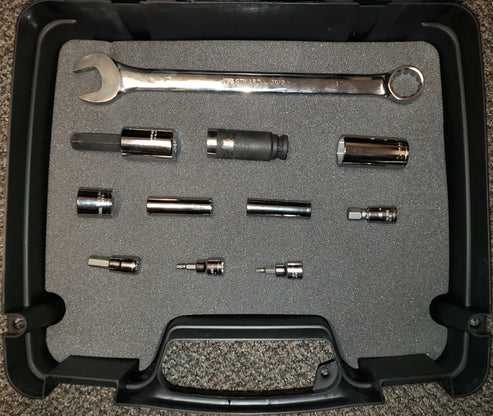What Type of Foam Is Best for Toolboxes?

The main operation of foam for toolboxes is to improve protection and organization notably. The foam offers the best cushioning, preventing any movement in transit while helping to keep tools within reach. There is a diverse range of options available, and knowing about the varied forms of foam will help one make the right decision. In our post today, we are going to check out the various types of tool foam inserts that are made available for toolboxes aiming toward density, durability, and operations.
Why Foam Matters in Tool Boxes?
Toolboxes are often important for the tradesperson or the DIY enthusiasts. They protect the well-worth tools from any possible damage, making transportation seamless. The foam adds another layer of protection that can help absorb the shocks while preventing the tools from moving or shifting out of place. Selecting the appropriate kind of foam can ensure that the tools stay in the right condition, prepared for use whenever required.
Types of Foam Suitable for Tool Boxes
Different types of foam are available for the toolboxes, each with distinctive properties catering to unique needs.
EVA Foam (Ethylene Vinyl Acetate)
EVA of Ethylene Vinyl Acetate foam is the prominent kind due to its lightweight condition in their kind and the best level of shock absorption. It is a closed-cell foam that resists all types of moisture and chemicals, making it the best for the toolboxes that are used outdoors. EVA foam offers the ideal sort of cushioning and is frequently used across the custom inserts, fitting appropriately around the tools while minimizing movement during transit.
Polyethylene Foam
Polyethylene foam remains distinctive for its rigidity and durability. Its higher resistance to damage makes it suited for heavy-duty applications. This kind of foam, withstanding all kinds of impacts, is frequently used for toolboxes made across industries. The availability of varied densities enables the users to opt for the appropriate amount of protection for the tools.
Polyurethane Foam
Polyurethane foam is a highly versatile option commonly used in numerous applications. It comes in varied densities, enabling better customizations based on distinctive needs. Softer than polyethylene, polyurethane renders the industry’s best cushioning. It is the kind of foam discovered in the liners of the toolboxes and the custom inserts to ensure that the tools are securely held in place.
Convoluted Foam
This foam type is also referred to as egg crate foam due to its unique structure, which provides another layer of support. It has a perforated structure, which is very effective for tools that can be affected by moisture. This foam is lighter and thinner, meant for holding lesser tools and toolboxes that do not require very tough and durable foam to protect them.
Closed-Cell Foam
Closed-cell foam is one of the high-density options that offers excellent resistance to moisture and insulation features. Inherent in its ability to resist water penetration, it is useful for toolboxes that are exposed to weather conditions. Shutting the foam thus provides optimal cushioning to absorb shocks and vibrations that might affect the tools during transport.
Key Factors for Selecting the Right Foam
Tool Type and Weight
Foam selection is also affected by the type and weight of the tools stored since they determine the load the foam has to support. Larger tools may call for sturdier material like the foam while smaller equipment can be kept in the less rigid ones. Determine the amount of protection required in a tool depending on the material and design it comes with.
Usage Scenarios
With a toolbox, think of how and where you will be using it more often. If those tools are affected by dust, water, or heavy dropping, then use foam that will provide the required protection based on those factors. For instance, the foams used on job sites might require effective, resistant foams, while tools stored in spare rooms might require less resistant foams.
Custom Fit
Most toolboxes are produced with cut-to-fit foam inserts, so your tools will fit snuggly into them. This design of the toolbox organizer foam reduces motion and ensures that the object and the individual’s body are shielded. If a specific set of tools has to fit well, then such tools should be packed in foams that are cut to the right size, or that can easily be cut to the right size.
Budget Considerations
Foam is a product that comes in different types with varying densities, and as such, the prices for the foam are also different. Look at your budget and check how much it will be more cost-effective to go with quality foam in the long run. As most people like to spend as little cash as possible, they go for a cheaper version of foam, but as has been seen, the higher quality foam has greater resistance to shock and lasts longer, thus being economical in the long run.
Tips for Maintaining Foam Inserts
To maximize the lifespan of your foam inserts, follow these maintenance tips:
Regular Cleaning: Some of the recommendations when using foam include washing the tools, replacing them when necessary, and washing the foam regularly with a damp cloth. This practice protects the foam’s surface from getting contaminated with dirt and debris, hence enhancing its life span.
Avoid Excessive Moisture: Moisture-resistant foams may also deteriorate after some time. If the toolbox gets wet, remove your tools from the foam and place them in another secure location; wait for the foam to dry before you return the tools to their compartment.
Inspect for Damage: Inspect the foam for signs of damage regularly. Finding damage or an excessive amount of compression should prompt immediate consideration of replacing the foam to maintain a better level of protection.
Store Tools Properly: After use, the tools are often placed right at the back of their spots. This habit keeps the tools organized while reducing unnecessary damage to the foam and preventing overcrowding.
Conclusion
Selecting the appropriate foam for your toolbox improves organization and guards against damage to priceless instruments. Considering choices such as closed-cell foam, convoluted foam, polyethylene, polyurethane, and EVA, it is crucial to assess individual requirements and preferences. Various factors, including tool kind, money, and environment, are critical in the decision-making process. Purchasing high-quality foam increases productivity when working on projects and protects instruments.




